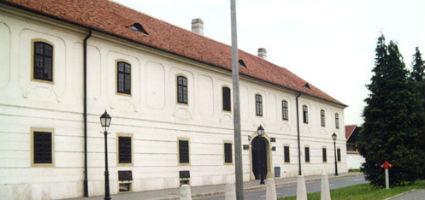2024. April 16. Tuesday
Region Historical Exhibition and J. Haydn Memorial Hall - Fertőd
 |
Address: 9431, Fertőd Madách sétány 1.
Phone number: (99) 537-013
E-mail: fertod@matavnet.hu
Opening hours: 01.04-01.09
On prior notice |
Southeast of Sopron, between Sopron and Győr, a town is located in the land of the Fertő-Hanság. Besides its national buildings and other places of interest, it is also the economic and cultural center of the region.
Fertőd received its name after the reorganization of administration on 16, May 1950. The town Eszterháza took on the name Fertőd. On 7, September the village Süttör joined to it. Süttör was the oldest settlement; its name was preserved in documents as Sihtur, Sehtur, Sehter. The name of Eszterháza was first mentioned in a letter sent by the prince Miklós herceg (1766): "Schloss Eszterháza".
A horseshoe shaped beautiful Baroque castle, the main place of tourist interest is situated in the center of the town. It was began to be built by Esterházy József in the 1720`s.
J. Haydn (1732-1809), the last court composer of music history, spent two decades (1769-1790) in the castle serving the prince Esterházy Miklós. Haydn lived in the Music House where a memorial room is open in his honor.
The castle, also the home of the Mayor's Office and the library, the Haydn Memorial Room and the Music School, is one of the most beautiful Baroque monuments in Fertőd
The history of Fertőd presented is based on the research works in the archives such as the documents on the recruiting of 1848, the list of the names of soldiers and property owners, the Esterházy family and the most important moments of the civic period.
We also provide an insight into the local traditions, the old and present day civil organizations and the music life of the place.
Temporary exhibitions await the visitors in the hallways and the wards in the summers. Last time the pictures of Udvardi Erzsébet were shown.
The Fertő-Hansági National Park is a considerable place of interest with its rare flora and fauna. A bicycle road connects it with Austria over the Fertő-Pamhagen (Pomogy).
Two Roman Catholic churches are situated in the town: the Saint Andreas Church was built in the Neo Gothic Style and the Saint Cross Church was built in 1986. It is ornamented with the station pictures of - Udvardi Erzsébet. The recently restored chapel of the castle received the Europe Nostra Prize. The town with 3300 citizens became town in 1995.
The Fertő-Hanság National Park, the proximity of the Lake Fertő, the settlements around the Fertő became part of the world heritage on account of their beautiful environment, cultural values and culture in 2001.
Bertha János, educational officer
Fertőd received its name after the reorganization of administration on 16, May 1950. The town Eszterháza took on the name Fertőd. On 7, September the village Süttör joined to it. Süttör was the oldest settlement; its name was preserved in documents as Sihtur, Sehtur, Sehter. The name of Eszterháza was first mentioned in a letter sent by the prince Miklós herceg (1766): "Schloss Eszterháza".
A horseshoe shaped beautiful Baroque castle, the main place of tourist interest is situated in the center of the town. It was began to be built by Esterházy József in the 1720`s.
J. Haydn (1732-1809), the last court composer of music history, spent two decades (1769-1790) in the castle serving the prince Esterházy Miklós. Haydn lived in the Music House where a memorial room is open in his honor.
The castle, also the home of the Mayor's Office and the library, the Haydn Memorial Room and the Music School, is one of the most beautiful Baroque monuments in Fertőd
The history of Fertőd presented is based on the research works in the archives such as the documents on the recruiting of 1848, the list of the names of soldiers and property owners, the Esterházy family and the most important moments of the civic period.
We also provide an insight into the local traditions, the old and present day civil organizations and the music life of the place.
Temporary exhibitions await the visitors in the hallways and the wards in the summers. Last time the pictures of Udvardi Erzsébet were shown.
The Fertő-Hansági National Park is a considerable place of interest with its rare flora and fauna. A bicycle road connects it with Austria over the Fertő-Pamhagen (Pomogy).
Two Roman Catholic churches are situated in the town: the Saint Andreas Church was built in the Neo Gothic Style and the Saint Cross Church was built in 1986. It is ornamented with the station pictures of - Udvardi Erzsébet. The recently restored chapel of the castle received the Europe Nostra Prize. The town with 3300 citizens became town in 1995.
The Fertő-Hanság National Park, the proximity of the Lake Fertő, the settlements around the Fertő became part of the world heritage on account of their beautiful environment, cultural values and culture in 2001.
Bertha János, educational officer
|
Permanent exhibitions
|
|